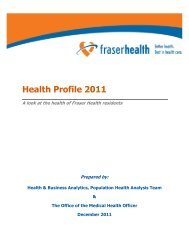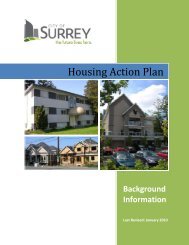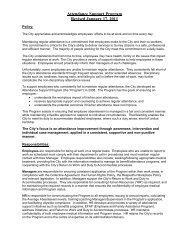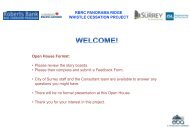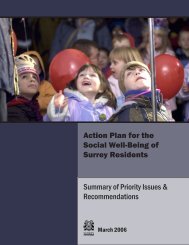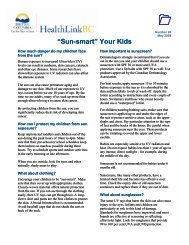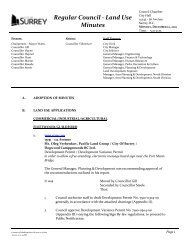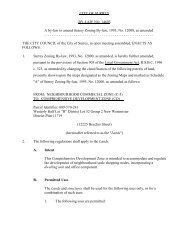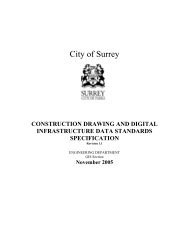Blackie Spit Park: Wildlife Habitat Enhancement Plan - City of Surrey
Blackie Spit Park: Wildlife Habitat Enhancement Plan - City of Surrey
Blackie Spit Park: Wildlife Habitat Enhancement Plan - City of Surrey
You also want an ePaper? Increase the reach of your titles
YUMPU automatically turns print PDFs into web optimized ePapers that Google loves.
Executive Summary<br />
The process <strong>of</strong> designating <strong>Blackie</strong> <strong>Spit</strong> as a park and the development <strong>of</strong> management direction<br />
has taken place over several decades. Through a process <strong>of</strong> public consultation, the <strong>Blackie</strong> <strong>Spit</strong><br />
<strong>Park</strong> Master <strong>Plan</strong> (Catherine Berris and Associates and Dillon Consulting, 1999) provided overall<br />
direction for the park, that being ‘to protect the long-term environmental integrity <strong>of</strong> <strong>Blackie</strong> <strong>Spit</strong><br />
while providing opportunities for community and nature-based uses’. Subsequently, this wildlife<br />
habitat enhancement plan was commissioned to address the specific wildlife habitat management<br />
opportunities in the context <strong>of</strong> a park that has a long history <strong>of</strong> passive recreational use.<br />
<strong>Blackie</strong> <strong>Spit</strong> <strong>Park</strong> is the product <strong>of</strong> a haphazard management history. Originally forming part <strong>of</strong><br />
the Nicomekl River estuary, parts <strong>of</strong> it were dyked for farming. Subsequently, three dredging<br />
episodes resulted in sandy dredgate being dumped on the former marshes and parts <strong>of</strong> the<br />
farmland. Currently the park consists <strong>of</strong> dyked farmland, old and new dykes and drainage ditches,<br />
varying ages <strong>of</strong> dredgate, the sandy spit and relatively natural estuary in which old pilings provide<br />
evidence <strong>of</strong> a former oyster cannery. The current vegetation patterns, therefore, reflect that<br />
history and the substrates, mostly <strong>of</strong> dredgate origin in the north and <strong>of</strong> estuarine origin in the<br />
south, are the most influential determinant <strong>of</strong> the habitat potential.<br />
Development <strong>of</strong> the plan began by examining the existing and potential habitat potential <strong>of</strong> the<br />
park in conjunction with staff <strong>of</strong> <strong>Surrey</strong> <strong>Park</strong>s, Recreation & Culture and members <strong>of</strong> the White<br />
Rock and <strong>Surrey</strong> Naturalists. The park was then divided into 19 Management Units that reflected<br />
existing patterns <strong>of</strong> land form, habitat development, or land use. Individual habitat management<br />
plans were developed that consisted <strong>of</strong> the establishment <strong>of</strong> wildlife species goals, habitat<br />
management objectives, and detailed management activities. The development <strong>of</strong> the<br />
management prescriptions for each unit were also influenced by the nature <strong>of</strong> adjacent units, thus<br />
recognizing the integrated complex <strong>of</strong> habitats in the park.<br />
Part1 <strong>of</strong> the report provides an overview <strong>of</strong> the wildlife and habitat values <strong>of</strong> the park and explains<br />
the management approach and outlines the methods by which the plan was developed. It also<br />
summarizes the Management Unit goals, costs, and habitat monitoring and maintenance<br />
requirements. <strong>Wildlife</strong> monitoring goals and methods are also outlined so that baseline<br />
information can be collected and the success <strong>of</strong> the management prescriptions measured.<br />
Part 2 <strong>of</strong> the report consists <strong>of</strong> management plans for each <strong>of</strong> the 19 Management Units. Each<br />
plan comprises the following elements:<br />
1.0 Existing Conditions<br />
2.0 Goals and Objectives<br />
3.0 Management Prescriptions<br />
3.1 Initial <strong>Enhancement</strong> Requirements<br />
3.2 Ongoing Maintenance Requirements<br />
3.3 Initial <strong>Enhancement</strong> Costs<br />
3.4 Monitoring Schedule<br />
<strong>Blackie</strong> <strong>Spit</strong> <strong>Park</strong>: <strong>Wildlife</strong> <strong>Habitat</strong> <strong>Enhancement</strong> <strong>Plan</strong> – PART 1: Background and Summary<br />
ii



